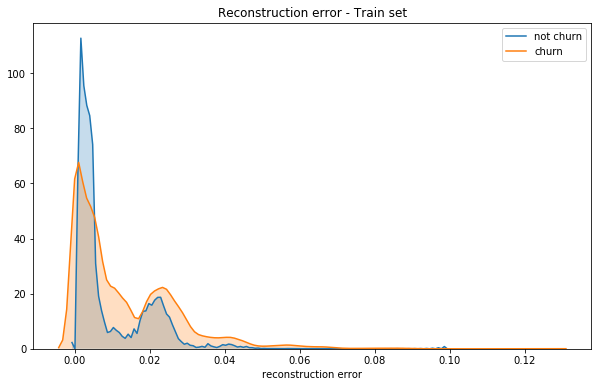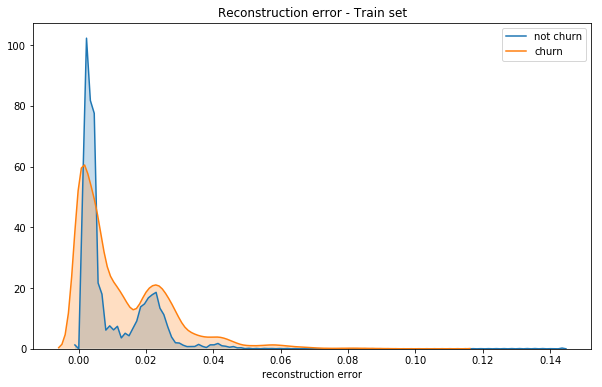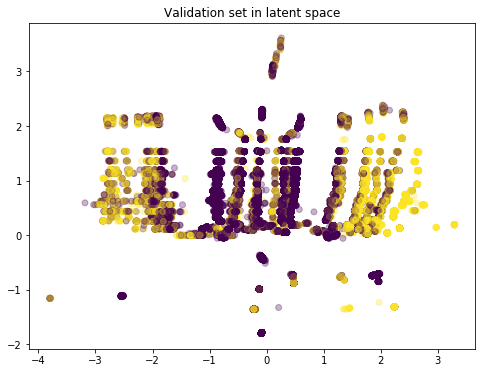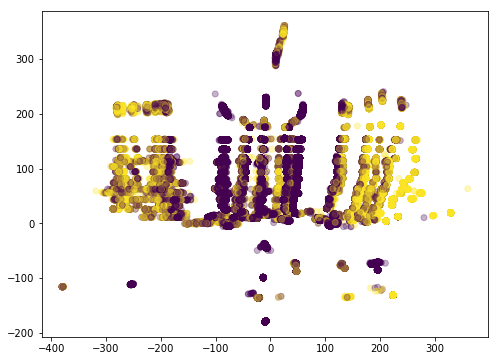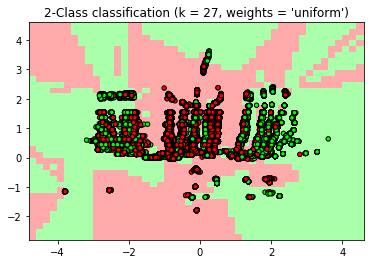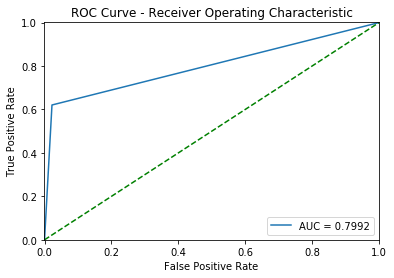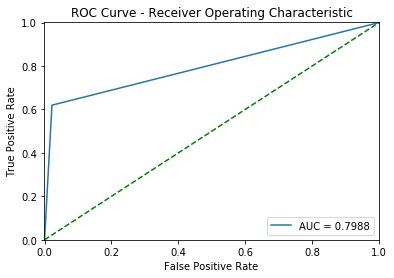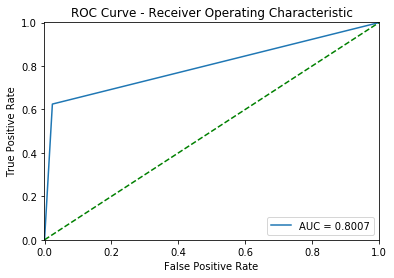import os1. Read the data and create dummy variables for the catecorial fetures. 2. Create, and train variational autoencoder, that decode the data into a 2 dimentional latent space. 3. View the data in the latent 2D space, and check classification astrategies.
* https://wiseodd.github.io/techblog/2016/12/10/variational-autoencoder/
* The data can be downloaded at the kaggle competition website. * Data reading, aggregation and feture engeeniring, here: https://github.com/naomifridman/Neural-Network-Churn-Prediction. Small data sample can be found here as well.
import pandas as pd
import numpy as np
from sklearn.preprocessing import StandardScaler,MinMaxScaler
import collections
# For plotting
%matplotlib inline
import matplotlib.pyplot as plt
import seaborn as sns
from sklearn.metrics import (confusion_matrix, precision_recall_curve, auc,
roc_curve, recall_score, classification_report, f1_score,
precision_recall_fscore_support)test=pd.read_csv('test_data.csv')
train= pd.read_csv('train_data.csv')print train.columns
from sklearn.utils import shuffle
train = shuffle(train)Index([u'msno', u'is_churn', u'trans_count', u'payment_method_id',
u'payment_plan_days', u'plan_list_price', u'actual_amount_paid',
u'is_auto_renew', u'transaction_date', u'membership_expire_date',
u'is_cancel', u'logs_count', u'date', u'num_25', u'num_50', u'num_75',
u'num_985', u'num_100', u'num_unq', u'total_secs', u'city', u'bd',
u'gender', u'registered_via', u'registration_init_time'],
dtype='object')
train.head()
<style>
.dataframe thead tr:only-child th {
text-align: right;
}
</style>
.dataframe thead th {
text-align: left;
}
.dataframe tbody tr th {
vertical-align: top;
}
| msno | is_churn | trans_count | payment_method_id | payment_plan_days | plan_list_price | actual_amount_paid | is_auto_renew | transaction_date | membership_expire_date | ... | num_75 | num_985 | num_100 | num_unq | total_secs | city | bd | gender | registered_via | registration_init_time | |
|---|---|---|---|---|---|---|---|---|---|---|---|---|---|---|---|---|---|---|---|---|---|
| 448226 | PpcGaLDnaqbR0rFnSjE1ePlq8Iwg+I/496p/3C1sk6M= | 0 | 5 | 41.0 | 30.0 | 99.0 | 99.0 | 1.0 | 20170310.0 | 20170410.0 | ... | 1.0 | 0.0 | 73.0 | 76.0 | 19664.449 | 5.0 | 23.0 | 1.0 | 7.0 | 20161110.0 |
| 23523 | 3mbiROk+stv5bpSoSBamETsOdsGvI2tYkizEyt5NLE4= | 1 | 14 | 0.0 | 0.0 | 0.0 | 0.0 | 0.0 | 0.0 | 0.0 | ... | 0.0 | 1.0 | 39.0 | 40.0 | 10252.677 | 15.0 | 22.0 | 1.0 | 9.0 | 20150825.0 |
| 121396 | uYcPOte+AR3WoaBIyf/ZRMYw0lggV7SFLdgpQJHcsgg= | 0 | 27 | 36.0 | 30.0 | 180.0 | 180.0 | 1.0 | 20170312.0 | 20170411.0 | ... | 1.0 | 0.0 | 0.0 | 2.0 | 126.171 | 22.0 | 21.0 | 2.0 | 7.0 | 20150307.0 |
| 984074 | YWiGHcibaJjX3HvGhHnvtm4YFWOAtaq+EqcEC9x1b+A= | 0 | 22 | 39.0 | 30.0 | 149.0 | 149.0 | 1.0 | 20170331.0 | 20170505.0 | ... | 0.0 | 1.0 | 25.0 | 33.0 | 6721.551 | 5.0 | 36.0 | 2.0 | 9.0 | 20100326.0 |
| 1900366 | Y1hlZ5xC1BHdsayrSBRS7qjQ81aEbNIA8vWr9zuPL1M= | 0 | 17 | 41.0 | 30.0 | 100.0 | 100.0 | 1.0 | 20170331.0 | 20170430.0 | ... | 1.0 | 0.0 | 150.0 | 121.0 | 35802.106 | 1.0 | 0.0 | 0.0 | 7.0 | 20160107.0 |
5 rows × 25 columns
def agg_col_by_chrn(dfo, col, drow = True):
h = dfo.groupby([col,'is_churn']).agg(len)
v= h.msno
dn =pd.DataFrame()
dn['not'] = v.loc[pd.IndexSlice[:,0]]
dn['churn']= v.loc[pd.IndexSlice[:,1]]
dn = dn.fillna(0.)
if (drow):
dn.plot(kind='bar', stacked=True, color=['b','y'])
plt.title(col)
dn['percent'] = dn.churn * 100. / (dn['not'] + dn.churn)
dn['sum'] = dn.churn +(dn['not'])
dn = dn.sort_values('percent')
dn = dn.reset_index()
return dndef agg_col(dfo, col, drow = True):
h = test.groupby([col,'is_churn']).agg(len)
v= h.msno
dn =pd.DataFrame()
dn['sum'] = v.loc[pd.IndexSlice[:,0]]
dn = dn.fillna(0.)
if (drow):
dn.plot(kind='bar', stacked=True, color=['b','y'])
plt.title(col)
dn = dn.reset_index()
return dndef drow_col(df, col):
dft = train[[col,'is_churn']]
dft0 = dft[dft.is_churn==0]
dft1 = dft[dft.is_churn==1]
sns.kdeplot(dft0[col], label='not churn', shade=True)
sns.kdeplot(dft1[col], label='churn', shade=True)
plt.xlabel(col);def order_col_by_churn_percent(col,drow=True):
dn = agg_col_by_chrn(train, col, drow = False)
tmp = dn[[col]].to_dict()
val_map= tmp[col]
inv_map = {v: k for k, v in val_map.items()}
train[col] = train[col].replace(inv_map)
test[col] = test[col].replace(inv_map)
if (drow) :
drow_col(train, col)col= 'registered_via'
print 'registered_via', collections.Counter(train['registered_via'])registered_via Counter({7.0: 945410, 9.0: 472309, 0.0: 225763, 3.0: 211904, 4.0: 102027, 13.0: 6478})
order_col_by_churn_percent(col)col = 'payment_method_id'
print 'city',collections.Counter(train[col])city Counter({41.0: 1096538, 40.0: 145608, 36.0: 130614, 39.0: 128210, 0.0: 93166, 38.0: 79695, 37.0: 74482, 34.0: 57618, 30.0: 30987, 33.0: 28344, 29.0: 28074, 31.0: 20694, 32.0: 17269, 15.0: 4338, 23.0: 4190, 27.0: 3718, 35.0: 3435, 28.0: 3240, 19.0: 2588, 20.0: 1866, 21.0: 1758, 16.0: 1588, 18.0: 1272, 22.0: 1144, 14.0: 1085, 13.0: 823, 17.0: 616, 12.0: 490, 26.0: 171, 11.0: 150, 10.0: 74, 8.0: 21, 6.0: 14, 3.0: 11})
order_col_by_churn_percent(col)col = 'city'
print 'city',collections.Counter(train[col])city Counter({1.0: 897987, 0.0: 225763, 13.0: 195417, 5.0: 142005, 4.0: 95172, 15.0: 86543, 22.0: 84120, 6.0: 52088, 14.0: 40180, 12.0: 22937, 9.0: 19084, 11.0: 18174, 18.0: 15634, 8.0: 15279, 10.0: 13003, 17.0: 11022, 21.0: 10485, 3.0: 10146, 7.0: 5318, 16.0: 1900, 20.0: 1354, 19.0: 280})
order_col_by_churn_percent(col)col = 'gender'
dn = agg_col_by_chrn(train, col)order_col_by_churn_percent('gender')def aply_oonehot(df, col):
df_en = pd.get_dummies(df[col])
df_en = df_en.drop(df_en.columns[0], 1)
cols = [str(col)+'_'+str(c) for c in df_en.columns]
df_en.columns = cols
df = df.drop(col, 1)
df = pd.concat([df, df_en], axis=1)
return dftrain = aply_oonehot(train, 'city')
test = aply_oonehot(test, 'city')
train = aply_oonehot(train, 'registered_via')
test = aply_oonehot(test, 'registered_via')
train = aply_oonehot(train, 'gender')
test = aply_oonehot(test, 'gender')# will not create dummy fetures for payment_method_id, because there are many categories,
# and we will get big spars matrix
print train.columnsIndex([u'msno', u'is_churn', u'trans_count', u'payment_method_id',
u'payment_plan_days', u'plan_list_price', u'actual_amount_paid',
u'is_auto_renew', u'transaction_date', u'membership_expire_date',
u'is_cancel', u'logs_count', u'date', u'num_25', u'num_50', u'num_75',
u'num_985', u'num_100', u'num_unq', u'total_secs', u'bd',
u'registration_init_time', u'city_1.0', u'city_2.0', u'city_3.0',
u'city_4.0', u'city_5.0', u'city_6.0', u'city_7.0', u'city_8.0',
u'city_9.0', u'city_10.0', u'city_11.0', u'city_12.0', u'city_13.0',
u'city_14.0', u'city_15.0', u'city_16.0', u'city_17.0', u'city_18.0',
u'city_19.0', u'city_20.0', u'city_21.0', u'registered_via_1.0',
u'registered_via_2.0', u'registered_via_3.0', u'registered_via_4.0',
u'registered_via_5.0', u'gender_1.0', u'gender_2.0'],
dtype='object')
from sklearn.metrics import confusion_matrix
from sklearn.metrics import classification_report
from sklearn.metrics import cohen_kappa_score
from sklearn.metrics import accuracy_score, log_loss
def print_stats(ytest, ypred):
print("Accuracy: {:.5f}, Cohen's Kappa Score: {:.5f}".format(
accuracy_score(ytest, ypred),
cohen_kappa_score(ytest, ypred, weights="quadratic")))
ll = log_loss(ytest, ypred)
print("Log Loss: {}".format(ll))
print ' '
print("Confusion Matrix:")
print(confusion_matrix(ytest, ypred))
print("Classification Report:")
print(classification_report(ytest, ypred))def drow_roc_curve(y_true, y_pred):
fpr, tpr, thresholds = roc_curve(y_true, y_pred)
roc_auc = auc(fpr, tpr)
plt.title('ROC Curve - Receiver Operating Characteristic')
plt.plot(fpr, tpr, label='AUC = %0.4f'% roc_auc)
plt.legend(loc='lower right')
plt.plot([0,1],[0,1],'g--')
plt.xlim([-0.001, 1])
plt.ylim([0, 1.001])
plt.ylabel('True Positive Rate')
plt.xlabel('False Positive Rate')
plt.show();def drow_history(history, metric):
plt.plot(history.history[metric])
plt.plot(history.history['val_'+ metric])
plt.title('model '+metric)
plt.ylabel(metric)
plt.xlabel('epoch')
plt.legend(['train', 'test'], loc='upper left')
plt.show() Since vae neural net is highly customized, data set size must be devided by batch size
from sklearn.model_selection import train_test_split
from sklearn.preprocessing import StandardScaler,MinMaxScaler
XX_train, XX_val = train_test_split(train, test_size=589200)
cols = [c for c in train.columns if c not in ['is_churn','msno']]
X_train = MinMaxScaler().fit_transform(XX_train[cols])
y_train = XX_train['is_churn'].as_matrix()
XX_val1 = MinMaxScaler().fit_transform(XX_val[cols])
yy_val1= XX_val['is_churn'].as_matrix()
X_real_test = MinMaxScaler().fit_transform(test[cols])
print y_train.shape, yy_val1.shape(1374691,) (589200,)
- Lets split validation set to validation and train sets
X_val, X_test, y_val, y_test = train_test_split(XX_val1, yy_val1, test_size=294600, random_state=42)
print y_train.shape, y_val.shape, y_test.shape, train.shape(1374691,) (294600,) (294600,) (1963891, 50)
Since vae neural net is highly customized, data set size must be devided bt batch size
def cut_array_to_fit_batchsize(X,y,batch_size):
n_size = (len(X)//batch_size)*batch_size
X = X[0:n_size]
y = y[0:n_size]
return X, ybatch_size = 100
X_train, y_train = cut_array_to_fit_batchsize(X_train,y_train, batch_size)
X_val, y_val = cut_array_to_fit_batchsize(X_val, y_val, batch_size)
X_test,y_test = cut_array_to_fit_batchsize(X_test,y_test, batch_size)
y_real_test=np.zeros((len(X_real_test)))
print X_val.shape, X_train.shape(294600, 48) (1374600, 48)
from keras.layers import Input, Dense, Lambda
from keras.models import Model
from keras.objectives import binary_crossentropy
from keras.callbacks import LearningRateScheduler
from IPython.display import SVG
from keras.utils.vis_utils import model_to_dot
from keras.callbacks import EarlyStopping, ModelCheckpoint
import keras.backend as K
from numpy.random import seed
seed(1)
# Define input layer
input_dim = X_train.shape[1]
input_layer = Input(shape=(input_dim,), name='input_layer')
# Define Encoder layers
hiden_layer_dim = 256
hiden_layer = Dense(hiden_layer_dim, activation='relu',
name='hiden_layer')(input_layer)
# Create 2 dense layer that outputs latent space dimention data
latent_space_dim = 2
mu = Dense(latent_space_dim, activation='linear', name='mu')(hiden_layer)
log_sigma = Dense(latent_space_dim, activation='linear', name='log_sigma')(hiden_layer)
# Encoder model, to encode input into latent variable
# We choose mu, the mean of the output as can be seen in the samle_z function.
# the mean is the center point, the representative of the gaussian
encoder = Model(input_layer, mu, name='encoder')
# Now the trick of the vae, to sample from the 2 dense layers
def sample_z(args):
mu, log_sigma = args
eps = K.random_normal(shape=(batch_size, latent_space_dim), mean=0., stddev=1.)
return mu + K.exp(log_sigma / 2) * eps
# Sample from the output of the 2 dense layers
sampleZ = Lambda(sample_z, name='sampleZ', output_shape=(latent_space_dim,))([mu, log_sigma])
# Define decoder layers in VAE model
decoder_hidden = Dense(hiden_layer_dim, activation='relu', name='decoder_hidden')
decoder_out = Dense(input_dim, activation='sigmoid', name = 'decoder_out')
h_p = decoder_hidden(sampleZ)
output_layer = decoder_out(h_p)
# VAE model, Unsupervised leraning for reconstruction of the input data
vae = Model(input_layer, output_layer, name='vae')
# Define a separate Decoder model, that recostruct data from latent variable
# The decoder model uses eights that was trained with the VAE mode;,
# We need a separate model, if we want to generate data from given data in latent space.
d_in = Input(shape=(latent_space_dim,), name='decoder_input')
d_h = decoder_hidden(d_in)
d_out = decoder_out(d_h)
decoder = Model(d_in, d_out, name='decoder')
SVG(model_to_dot(vae, show_shapes='true').create(prog='dot', format='svg'))def vae_loss(y_true, y_pred):
""" Calculate loss = reconstruction loss + KL loss for each data in minibatch """
recon = K.sum(K.binary_crossentropy(y_pred, y_true), axis=1)
kl = 0.5 * K.sum(K.exp(log_sigma) + K.square(mu) - 1. - log_sigma, axis=1)
return recon + klfrom keras.callbacks import Callback
vlos = float(10000.)
class SaveBest(Callback):
global vlos
vlos = float(10000.)
'''def on_train_begin(self, logs={}):
vlos = float(10000.)'''
def on_epoch_end(self, batch, logs={}):
global vlos
tmp = logs.get('val_loss')
if (tmp==None):
tmp = 1000.
if (vlos - float(tmp) > 0.000001) :
print 'loss improoved from: ', vlos, ' to: ', tmp, 'saving models'
vlos = float(tmp)
encoder.save('best_encoder.h5')
decoder.save('best_decoder.h5')
vae.save('best_vae.h5')
savebest = SaveBest()
vae.compile(optimizer='adam', loss=vae_loss)
vae_history = vae.fit(X_train, X_train, batch_size=batch_size, shuffle=True,
validation_data = (X_val, X_val),
epochs=200, callbacks = [EarlyStopping(monitor='loss',patience = 8), savebest])Train on 1374600 samples, validate on 294600 samples
Epoch 1/200
1374500/1374600 [============================>.] - ETA: 0s - loss: 8.0833loss improoved from: 10000.0 to: 7.85568392657 saving models
1374600/1374600 [==============================] - 57s - loss: 8.0833 - val_loss: 7.8557
Epoch 2/200
1374300/1374600 [============================>.] - ETA: 0s - loss: 7.7609loss improoved from: 7.85568392657 to: 7.75912235662 saving models
1374600/1374600 [==============================] - 63s - loss: 7.7609 - val_loss: 7.7591
Epoch 3/200
1374000/1374600 [============================>.] - ETA: 0s - loss: 7.7060loss improoved from: 7.75912235662 to: 7.73122607909 saving models
1374600/1374600 [==============================] - 67s - loss: 7.7060 - val_loss: 7.7312
Epoch 4/200
1374000/1374600 [============================>.] - ETA: 0s - loss: 7.6763loss improoved from: 7.73122607909 to: 7.7037429672 saving models
1374600/1374600 [==============================] - 71s - loss: 7.6763 - val_loss: 7.7037
Epoch 5/200
1374000/1374600 [============================>.] - ETA: 0s - loss: 7.6571loss improoved from: 7.7037429672 to: 7.68796549051 saving models
1374600/1374600 [==============================] - 72s - loss: 7.6572 - val_loss: 7.6880
Epoch 6/200
1373800/1374600 [============================>.] - ETA: 0s - loss: 7.6476loss improoved from: 7.68796549051 to: 7.6839558277 saving models
1374600/1374600 [==============================] - 77s - loss: 7.6477 - val_loss: 7.6840
Epoch 7/200
1373500/1374600 [============================>.] - ETA: 0s - loss: 7.6408loss improoved from: 7.6839558277 to: 7.67795627536 saving models
1374600/1374600 [==============================] - 86s - loss: 7.6408 - val_loss: 7.6780
Epoch 8/200
1374200/1374600 [============================>.] - ETA: 0s - loss: 7.6319loss improoved from: 7.67795627536 to: 7.66621088917 saving models
...
Epoch 166/200
1374400/1374600 [============================>.] - ETA: 0s - loss: 7.4615loss improoved from: 7.49666791568 to: 7.49596815294 saving models
1374600/1374600 [==============================] - 120s - loss: 7.4615 - val_loss: 7.4960
Epoch 167/200
1374600/1374600 [==============================] - 122s - loss: 7.4598 - val_loss: 7.5073
Epoch 168/200
1374600/1374600 [==============================] - 121s - loss: 7.4627 - val_loss: 7.4991
Epoch 169/200
1374600/1374600 [==============================] - 115s - loss: 7.4615 - val_loss: 7.5081
Epoch 170/200
1374500/1374600 [============================>.] - ETA: 0s - loss: 7.4623loss improoved from: 7.49596815294 to: 7.49299870878 saving models
1374600/1374600 [==============================] - 114s - loss: 7.4623 - val_loss: 7.4930
Epoch 171/200
1374600/1374600 [==============================] - 114s - loss: 7.4605 - val_loss: 7.5167
Epoch 172/200
1374600/1374600 [==============================] - 119s - loss: 7.4617 - val_loss: 7.5024
Epoch 173/200
1374600/1374600 [==============================] - 116s - loss: 7.4605 - val_loss: 7.5088
Epoch 174/200
1374600/1374600 [==============================] - 119s - loss: 7.4623 - val_loss: 7.5111
Epoch 175/200
1374600/1374600 [==============================] - 120s - loss: 7.4599 - val_loss: 7.5051
Epoch 176/200
1374600/1374600 [==============================] - 120s - loss: 7.4616 - val_loss: 7.4982
'''vae.compile(optimizer='adam', loss=vae_loss)
vae_history = vae.fit(X_train, X_train, batch_size=batch_size, shuffle=True,
validation_data = (X_val, X_val),
epochs=200)'''"vae.compile(optimizer='adam', loss=vae_loss)\nvae_history = vae.fit(X_train, X_train, batch_size=batch_size, shuffle=True, \n validation_data = (X_val, X_val),\n epochs=200)"
drow_history(vae_history, 'loss')x_train_encoded = encoder.predict(X_train)
pred_train = decoder.predict(x_train_encoded)
mse = np.mean(np.power(X_train - pred_train, 2), axis=1)
error_df = pd.DataFrame({'recon_error': mse,
'churn': y_train})
plt.figure(figsize=(10,6))
sns.kdeplot(error_df.recon_error[error_df.churn==0], label='not churn', shade=True, clip=(0,10))
sns.kdeplot(error_df.recon_error[error_df.churn==1], label='churn', shade=True, clip=(0,10))
plt.xlabel('reconstruction error');
plt.title('Reconstruction error - Train set')<matplotlib.text.Text at 0x7f59a86dd910>
x_train_encoded = encoder.predict(X_train)
pred_train = decoder.predict(x_train_encoded)
mseT = np.mean(np.power(X_train - pred_train, 2), axis=1)
error_df = pd.DataFrame({'recon_error': mseT,
'churn': y_train})
plt.figure(figsize=(10,6))
sns.kdeplot(error_df.recon_error[error_df.churn==0], label='not churn', shade=True, clip=(0,10))
sns.kdeplot(error_df.recon_error[error_df.churn==1], label='churn', shade=True, clip=(0,10))
plt.xlabel('reconstruction error');x_val_encoded = encoder.predict(X_val)
pred = decoder.predict(x_val_encoded)
mseV = np.mean(np.power(X_val - pred, 2), axis=1)
error_df = pd.DataFrame({'recon_error': mseV,
'churn': y_val})
plt.figure(figsize=(10,6))
sns.kdeplot(error_df.recon_error[error_df.churn==0], label='not churn', shade=True, clip=(0,10))
sns.kdeplot(error_df.recon_error[error_df.churn==1], label='churn', shade=True, clip=(0,10))
plt.xlabel('reconstruction error');
plt.title('Reconstruction error - Train set')<matplotlib.text.Text at 0x7f59a8428190>
x_train_encoded = encoder.predict(X_train)
plt.figure(figsize=(8, 6))
plt.scatter(x_train_encoded[:, 0], x_train_encoded[:, 1],
c=y_train, alpha=0.3)
plt.title('Train set in latent space')
plt.show()x_val_encoded = encoder.predict(X_val)
plt.figure(figsize=(8, 6))
plt.scatter(x_val_encoded[:, 0], x_val_encoded[:, 1],
c=y_val, alpha=0.3)
plt.title('Validation set in latent space')
plt.show()x_train_encoded = encoder.predict(X_train)
print x_train_encoded.shape, x_train_encoded[:, 0].shape, x_train_encoded[:, 1].shape, X_train.shape
#color_bar.set_alpha(1)
plt.figure(figsize=(8, 6))
plt.scatter(100.*x_train_encoded[:, 0], 100.*x_train_encoded[:, 1],
c=y_train, alpha=0.3)
plt.show()(1374600, 2) (1374600,) (1374600,) (1374600, 48)
from matplotlib.colors import ListedColormap
from sklearn import neighbors, datasets
weights='uniform'
n_neighbors=27
clf = neighbors.KNeighborsClassifier(n_neighbors, weights=weights)
X=x_train_encoded
y=y_train
clf.fit(X, y)
h=0.2
cmap_light = ListedColormap(['#FFAAAA', '#AAFFAA'])
cmap_bold = ListedColormap(['#FF0000', '#00FF00'])
# Plot the decision boundary. For that, we will assign a color to each
# point in the mesh [x_min, x_max]x[y_min, y_max].
x_min, x_max = X[:, 0].min() - 1, X[:, 0].max() + 1
y_min, y_max = X[:, 1].min() - 1, X[:, 1].max() + 1
xx, yy = np.meshgrid(np.arange(x_min, x_max, h),
np.arange(y_min, y_max, h))
Z = clf.predict(np.c_[xx.ravel(), yy.ravel()])
# Put the result into a color plot
Z = Z.reshape(xx.shape)
plt.figure()
plt.pcolormesh(xx, yy, Z, cmap=cmap_light)
# Plot also the training points
plt.scatter(X[:, 0], X[:, 1], c=y, cmap=cmap_bold,
edgecolor='k', s=20)
plt.xlim(xx.min(), xx.max())
plt.ylim(yy.min(), yy.max())
plt.title("2-Class classification (k = %i, weights = '%s')"
% (n_neighbors, weights))<matplotlib.text.Text at 0x7f59a8262ad0>
x_val_encoded = encoder.predict(X_val)
y_val_neibghour = clf.predict(x_val_encoded)
drow_roc_curve(y_val, y_val_neibghour)
print_stats(y_val, y_val_neibghour)Accuracy: 0.95058, Cohen's Kappa Score: 0.62989
Log Loss: 1.70702453317
Confusion Matrix:
[[266131 6057]
[ 8503 13909]]
Classification Report:
precision recall f1-score support
0 0.97 0.98 0.97 272188
1 0.70 0.62 0.66 22412
avg / total 0.95 0.95 0.95 294600
x_test_encoded = encoder.predict(X_test)
y_test_neibghour = clf.predict(x_test_encoded)
drow_roc_curve(y_test, y_test_neibghour)
print_stats(y_test , y_test_neibghour)Accuracy: 0.95029, Cohen's Kappa Score: 0.63031
Log Loss: 1.71710708706
Confusion Matrix:
[[265927 6039]
[ 8607 14027]]
Classification Report:
precision recall f1-score support
0 0.97 0.98 0.97 271966
1 0.70 0.62 0.66 22634
avg / total 0.95 0.95 0.95 294600
- The results are not bad, lets try improve then by adding reconstruction error, to the classification
weights='uniform'
n_neighbors=27
clf = neighbors.KNeighborsClassifier(n_neighbors, weights=weights)
X=np.concatenate((x_train_encoded, np.reshape(mse, (mse.shape[0],1))), axis=1)
y=y_train
clf.fit(X, y)
x_val_encoded = encoder.predict(X_val)
vals = np.concatenate((x_val_encoded, np.reshape(mseV, (mseV.shape[0],1))), axis=1)
y_val_neibghour = clf.predict(vals)
drow_roc_curve(y_val, y_val_neibghour)
print_stats(y_val, y_val_neibghour)Accuracy: 0.94979, Cohen's Kappa Score: 0.62739
Log Loss: 1.73422500022
Confusion Matrix:
[[265804 6384]
[ 8408 14004]]
Classification Report:
precision recall f1-score support
0 0.97 0.98 0.97 272188
1 0.69 0.62 0.65 22412
avg / total 0.95 0.95 0.95 294600






